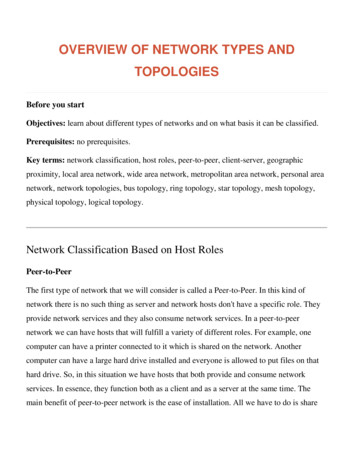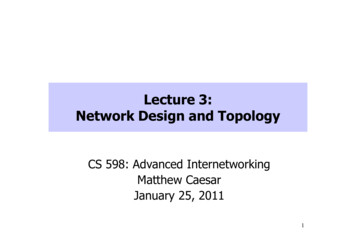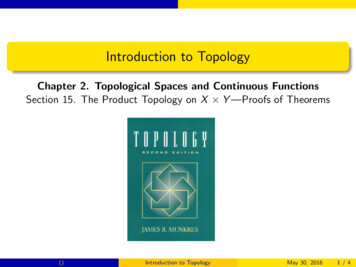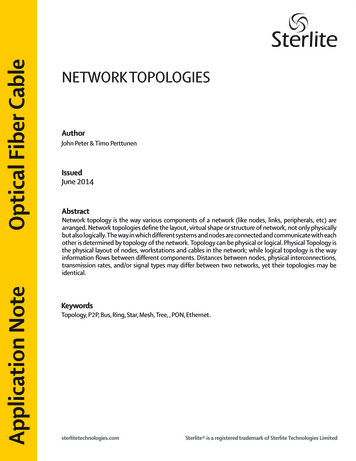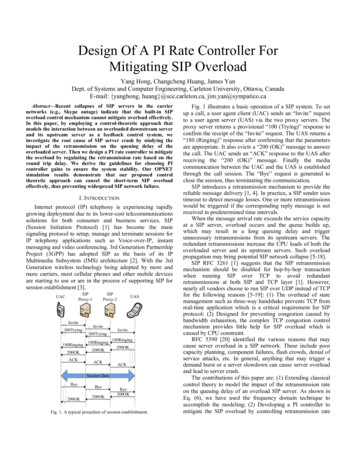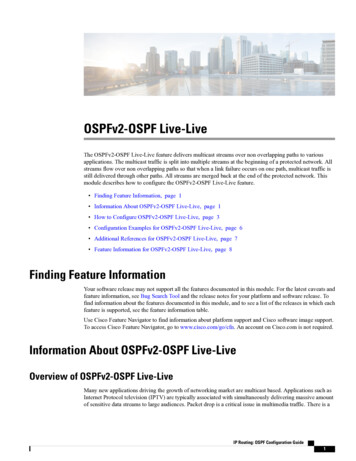
Transcription
BB22iJzTOPOLOGYAND ITSAPPLICATIONSTopologyELSEVIERand its Applications69 (1996) 251-264Least weight injective surfaces are fundamentalAbstractTo detect if there is an injective surface in a compact irreducible 3-manifold it suffices totriangulate the manifold and check only the fundamental surfaces (Jaco and Oertel, 1984). Herewe show that this is true simply because an injective surface of least weight will be fundamental.Haken manifold;IncompressiblesurfaceKeywords:AMS c./as.s(fificatim:Injective surface; Normal surface; FundamentalPrimary 57M50, Secondarysurface;57Q I51. IntroductionIn [2] Jaco and OertelThe criticalis Haken.constructibleshow there is an algorithmto decideif an irreduciblestep is to show that in any closed 3-manifoldset of surfaces in M so that M contains an injective3-manifoldthere is a finitesurface (different fromS*) if and only if one of the members of this finite set is injective.A central ingredient is Haken’s theory of normal surfaces [ 11. Haken shows that eachnormal surface can be constructed from a finite set of “fundamental”surfaces. The mainadvance in 12, Theorem 2.21, states that if a normal surface F in a closed irreduciblemanifold is two-sided and incompressible,then either it is fundamentalor it can bcconstructed from surfaces of smaller complexity which are also incompressible.In this paper we prove that the same result holds if we drop the hypothesis that Fis two-sided and replace incompressiblewith injective. This shows directly that, if Mcontains an injective surface F, then the fundamental surfaces used to construct F are* Corresponding author.’ Partially supported by a UCSB Graduate Research Mentorship Program grant.’ Partiallysupportedby NSF grant DMS 9203522.0166.X641/96/ 15.000 1996 Elsevier Science B.V. All rights reservedSSDlOl66-8641(95)00107-7
also injective. So (as also shown in (2, 3.51 by a somewhat more complicated route) todecide if M is Haken, it suffices to cheek if any fundamental surface is injective. We alsogeneralize(to nonorientablesurfaces in atoroidalHere is an outline:viewpoint3-manifolds)a finitenessresult [2, 2.31 on incompressible3-manifolds.In Section2 we review the theory of normalof [4]. In Section 3 we prove some preliminarysurfacesfrom theresults, mostly mild general-izations and reformulationsof proofs in [2]. In Section 4 we prove our main theorem,which says that if M is a closed irreducible manifold, F c M is an injective minimalweight surface, and F Fl F2 is in reduced form, then both Fl and F2 are injective. The proof is modeled on, but extends, [2, 2.21. Section 5 contains the applications,including the finiteness result: in any closed 3-manifold with no injective tori or Kleinbottles, there are at most a tinite number of injective surfaces of a given genus.2. The theoryof normalsurfacesLet M be a compact triangulated 3-manifold with a fixed triangulation7. Let Tidenote the i-skeleton. Suppose F is a properly embedded surface in n/r.Recall that a surface F C M3 is irljective if (incl), : 1(F) 1 (M) is injective. Asurface F is compressible if(1) F S2 and bounds a 3-ball,(2) there is an embedded disk D c L%l such that D il F aD, and aD is essentialin F.We now give a brief description of normal surfaces based on a more detailed reviewin [4]. An isotopy of M is called a rwrtnal isotopy (with respect to T) if it leaves thevarious simplices of 7 invariant. A properly embedded arc in a 2-simplex g is calledspanning if its ends lie on different sides of the triangle. A (simple) closed curve in theboundary ar of a tetrahedron 7 is called a curve type of 7 if it meets the faces of r inspanning arcs and meets any given face at most once A tetrahedron has up to normalisotopy precisely seven curve types. There are four curve types with three sides and threecurve types with four sides.If LYis a curve type in 7, and p is a point in the interior of 7, then the cone p*a of oto p is called a disk type of 7. Hence a tetrahedron has up to normal isotopy preciselyseven disk types.F c M is a nornzul surjtice if F intersects each tetrahedron of 7 in a (necessarilypairwise disjoint) collection of these disktypes.A normal surface is determined, up to normal isotopy, by the number of each curvetype in which it meets the boundaries of the various tetrahedra. Let Cl,., C,,, be anordering of the curve types. Then the surface F determines (and is itself determined) byan n-tuple ( 1, . . , x,,), where pi denotes the number of representatives of C, which Finduces in the tetrahedra of 7.If we start with an n-tuple of nonnegative integers, then we can construct a normalsurface in M corresponding to this TX-tuple if it satisfies the following constraints:
A. Barr, M. Scharlemunn/Topologyund its Applipliccctrons69 (1996) 251-264SurfaceSurface intersectsthetetrahedronin trianglesintersectstetrahedon253thein squaresFig. 1.(1) We can’t have two 4-sided disks from distinct normal isotopy classes in the sametetrahedron.(2) Edges of disktypeson correspondingfaces of incidenttetrahedrahave to match.Namely, if F intersects one face of a tetrahedron in p representativesof a certain arctype, then F also has to intersect the corresponding face of the incident tetrahedron in prepresentativesof the same arc type.A normal surface F in M is straight if it satisfies the following conditions:(I) For any 2-simplex c in T2, o n F consists only of straight spanning arcs (calledchords).(2) In each tetrahedron T any 3-sided disk in r n F is the triangle given by the convexhull of its vertices.(3) Any 4-sided disk in r f’ F is the cone to the barycenter of its four vertices.Clearly any normal surface can be normally isotoped to be straight. Now considerhow two straight normal surfaces F, and F2 intersect. First move them slightly so thatF1 n F2 fl T’ 8 and so that no barycenter of a 4-sided disk in F2 lies in Fl (and viceversa). Then7, F, n F2 consists of proper arcs, each of which hasits ends on distinct 2-simplices. Each end is a point in a 2-simplex CT4 r where a chordof Fl n u and a chord of F2 n o intersect.Lemma 2.1. In each tetrahedron
regular exchangenot a regular exchangeFig. 2.Consider how chords in a 2-simplex o can intersect. Let p be the intersection point.There is a unique way to remove an X neighborhood of p ‘and rejoin the endpoints ofthe X by two disjoint arcs so that the result gives two spanning arcs in U. This process iscalled a regulur exchange at y. The two opposite quadrants of X which are not connectedby this operation are called good cot etzs of the resultant spanning arcs at that point. Theother two quadrants of X arc called h tl corners.Now consider extending this regular cxchangc along an arc component C of Fi n F2inside a tetrahedron. That is, given two straight disks in a tetrahedron which intersectalong an arc C, try to remove a neighborhood of C from both Fi and F2 and reattachthe sides so that the result is a regular exchange at the ends of C. It is easy to see thatthis is possible, unless the disk types are distinct and both 4-sided.We say that normal surfaces Fl and F2 are conlputible if, in each tetrahedron, the foursided curve types of Fl and F2 (if any) are theafter they are straightened, WC have seen that init is possible to perform a regular exchange toresult of this operation on all intersection curvessame. If Fj and Fz are compatible then,a neighborhood of each curve of Fl n F2eliminate the curve of intersection. Theis a normal surface called the eonztvicF2. Denote this surface by Fl F2.There are several interesting properties which are additive with respect to the geometricsum operation.If Fl and F2 are compatible normal surfaces, then Fl F2 is defined andwhere x is Euler Characteristic,(I) x(Ft Fz) X(FI 1 x(F2L(2) if Fi corresponds to (51,, x7,) and F2 corresponds to (yt , . . , yfL), then Fl F2corresponds to (zt yt , . ! mTL y,,),(3) 2u(F1 F2) I w(Fz), w here w(F) weight of F 1F n 7” 1.It is then a theorem of Haken [I] that every normal surface can be built up from alinite set of “fundamental”surfaces by addition (always of compatible surfaces).sum of Fl and
A. Bert, M. Srharlcmtcnn / 7i pology and ifs Applicc tions 69 (1996) 251-26425.5Fig. 3.We will occasionally need to do a regular exchange along just a subset of Fi n F2and need to understand the consequences, so we examine spanning arcs in a 2-simplexCJmore carefully. Recall that a spanning arc that is a straight line is a chord.Lemma2.2. Suppose r and A are two families of disjoint chords in o and let 8 be the(not necessarilyembedded)collectionof urcs obtuined by a regular exchungeut someof the points in r n A. Then in fact each arc of 0 is an embedded spanning urc.Proof.The central idea is the following: In the case of two (but not more) families ofdisjoint chords it is always possible to find in 0 a train-track which carries both families.Even after some regular exchanges, each arc component will remain transverse to theI-fibers of the train-track and so will be an embedded spanning arc.Here is a more detailed account of this argument, stripped to its elementary core:Observe that the interior of any triangle AAOB can be foliated by proper open intervals,tangent to the sides of the triangle, so that(1) any chord in AAOB with one end on AB is transverse to the foliation,(2) any proper arc in AAOB that is transverse to the foliation has preciselyone endon AB.For example one way to construct such a foliation is to choose a point M in the sideAB, then in each of AAOMand ABOMchoose the fibers of the projection from Aand B to OM. Finally, connect the two by rounding corners near OM (see Fig. 3).Now consider r and A in 0 AABC.Assume, with no loss, that each containsat least one chord between any two sides of AABC.Then for each of r and A thereis a unique hexagonal complementarycomponent in AABCand these intersect. (Thisintersection might be empty for more than two families of chords.) Choose 0 to bea point in the intersection and build the foliation above in each of the three trianglesAOAB,AOBCand LIOCA. This produces a proper foliation 3 of the interior ofLIABC, with a 3-pronged singularity at 0, so that each chord of r and A is transverseto 3 and any l-manifold in AABCthat is everywhere transverse to 3 is a spanningarc. A regular exchange for r and A can then be defined locally as that exchange which
retains transversalityto FT. Hence any number of regular exchangestransversality, and the resulting arcs are embedded spanning arcs.0An importantapplicationof this lemma is the followingwill not destroyresult:Proof. The alternative is that T is disjoint from the I-skeleton, yet must still intersectthe %-skeleton since no intersection curve is entirely contained in a tetrahedron. Let obe a 2-simplex which T intersects. Then the simple closed curves T n (T are obtainedfrom the families of disjoint spanning chords r Fl f’ o and n F2 n cr by regular0exchanges at some intersection points. This contradicts Lemma 2.2 above.There is also a version of Lemmatypes in a tetrahedron.3. PreliminaryTheorem2.2 for rand il compatiblesets of disjointdiskresults3.1. Suppose M is u closed irreducible 3-ttzanijold urld FcM is incompress-ible. Then F is isotopic to u normul .sutj&e of no greater weight.The proof can be found in [4].Theorem3.2. Suppose M is a closed irreducible 3-manifold and Fc M.Then(1) F irljecdive F ittcot lpres.sihle,(2) if F is a-sided then F is it!jcctive c F i.s itlcontpre.ssible,(3) F is injective F a(,//(F))Proof.An easy exercise.nA patch for Fl F2 is a componentLemmaProof.is itt otttl’r ,ssihlc.of FI \ F2 or F2 \ F,.3.3. If a patch is a disk, theta its weight is greater than zero.(See also [4, p. 1641.) Let C CID, where D is a patch. Since Fleach tetrahedron in proper arcs, C n T2 # 8. If’ D n T’ 8 thenis a collection of proper arcs in D. Consider an outermost arc in D,a 2-simplex g. Then the segment of C cut off by the outermost arcof Fl I- F2 n (tetrahedron)with both ends on the same simplex (7.Theorem 2.1. 0n F2 intersectsD n (T’\ T’)lying entirely inis a componentThis contradicts
3.4. EIW if iIll is nonorientuhle,Lemmaorientable.Proof.u neighborhoodof un intersectioncurve C isThw C is either I-sided in both Fl und F2, or 2-sided in both,pick a surface, FI say. Given a point p in C and a vector 711normal toArbitrarilyC in FI at p, there is a unique normal 712to C in F2 at p so that 71 and 712are adjacentto the same good corner. The orientation ( 1,q ) is independent of the choice of hqsince -711 and -7,9 also abut a good corner. Hence this rule determineswell-defined normal orientation to all of C. 0a continuous3.5. u h1 is not RP3 and is irreducible, then the boundan’ of any disk-patchCorollaryof’ Fl F2 is 2.sided.Suppose D is a disk-patch of Fl \ F2. If aD is l-sided in Fj, then the componentof Fj containing D is RP’. We also know from Lemma 3.4 that RP’ is l-sided. HenceProof.‘/(RP2) RP’\ B”. IWe say a surface F c M is of minimaf weight if it cannot be isotoped to a surfacewith lower weight. By Theorem 3.1 a minimal weight incompressiblesurface is normal.A surface is least weight injective if it is of lowest weight among all injective surfaces.F F, F2 is in reduceclform, if the value of /Fl n F21 is minimal amongst all normalsurfaces F/ and F: isotopic to Fl and F2 such that F F,’ F:Lemma3.6. Let F3-manifoldbe m minimul weightnormuls rlfhce in a closedirreduciblen/l. Jf‘ F Fl F2 is in reduced f?jt-m und F is incompressibletively injective),(respec-then( I ) each patch is incompressible(respectivelyinjective),(2) no patch of Fl F2 is a disk.Proofthat(1). Suppose that P is a compressiblepatch of F Fl F2.disk D for P is also a compressing disk for 5’ unless aD bounds a disk(2) impliesA compressingD’ in F. But even then there is a diskpatchcx(patchesin D’) x(D’)To prove the injectivesince 0.case, suppose P is a patch which is not injective.As in Theo-rem 3.2 let F av(F) and F, &?(F,). Note that F Fl C & and that each doublecurve of F corresponds to a double curve of F. We know that the map p: F F isa two-fold cover and that, except over small annulus or Miibius band neighborhoods ofFI n Fz, p maps patches to patches. Let D be a compressing disk for F p-‘(P).SinceF is incompressible aD bounds a disk n in F and aA lies entirely in F Theremust be double curves in A, otherwise aD would be inessential in p. Since x(A) 0,there is a patch PO in F with x(Po) 0, i.e., PO is a disk-patch of F. Then &PO) is adisk-patch in F itself.D is a disk-patch of Fi \ F 2 which has least weight w(D) ( 03.3) among all disk patches in FI or F2. If C aD were l-sided in FI thenProof of (2). Supposeby Lemma
dd’Fig. 4.Fl RP2 and from Corollary3.5, AI RP3. But F injectivein RP’implies that F isisotopic to Fl, whereas w(F) w(Fl) w(Fz), contradicting F minimal weight. Thuswe know that C produces two curves cy and cy’ in F. One bounds the patch D in Fl, theother bounds a disk D’ in F, since F is incompressible.D’ must contain a disk-patchsince C x(patches) x(D’) 0.Now w(D’) w(D) (otherwise trade D’ in for D and get a lower weight for F).In particular, the disk-patches in D’ have total weight 6 w(D). Since w(D) is minimalamong disk-patches, and D’ must contain at least one disk patch there is exactly onedisk-patch in D’ and its weight is equal to w(D). Then every other patch in D’ must bean annulus of weight zeroSuppose D’ itself is a patch (and recall that w(D) (0’)).Construct F from Fj andFz in two steps: first, perform a regular switch on C only (call this F,’ UF2/), followed bydoing a regular switch along all other double curves (call this final result F,’ F2/).Notethat F{ and F2/are Fl and F2 with D and D’ switched. Since M is irreducible, F{ - Fland F2) N F2, and note that F,’ F-j is in a more reduced form. This contradicts theassumption that F is in reduced form. So D’ is not itself a patch. (But D’ does containa disk-patch.)Let {Pt , P2, . , P,,} be the set of all the disk-patches in Fl or F2 that have weightw(D). We found a way to assign to each Pi a P,: After doing the regular switchC, aP, is represented by two curves: cry1which bounds P, and c i which bounds adisk 0:. containing PJ. But there arc only finitely many Pi, hence we must cycle backat some point. (Note that we could have a cycle consisting of only one P,.) In generalwe will have some cycle PI P2 Pk: t PI, where P, P, I, aPi CY,and(1:. is parallel to apt , in F. Moreover, the annulus Ai in F between CY and aPi , hasTo(Ai) 0.Let T be the union of the A, along the cr,, a union of weight zero annuli, hence atorus or Klein bottle T with w(T) 0. But T is a surface obtained by double curve sumon all curves except Ci , . , Ck. This contradicts Proposition 2.3. 0
A. Burt, M. Schurlemunn4. MainTheorem/ Ephgyundits Applicutions69 (1996) 251-264259result4.1. Let M be u closedirreduciblemanifold. rf F is un injective,minimalweight surface in M and F FI F2 is in reduced form, then FI and F2 are injective.not, and assume with no Ioss of generality that F is connected and F,is not injecttie. Then Ft a(q(Fj )) is compressible by Theorem 3.2. Let (0, aD c(M\r@i) Fl) b e a compressing disk for Ft chosen so that 1D n F2 1 is minimal.We will look at the following 3 cases and show that each leads to a contradiction:Case 1: DnF, Q].Case 2: D n F2 contains simple closed curves.Proof.SupposeCase 3: D I-IF2 containsonly arcs.Case 1: D n F2 0. Since 8D is nontrivialin 1 (Fl), it’s nontrivialin F, \ F2, sothe patch of FI in which aD lies is not injective. This contradicts Lemma 3.6.Case 2: D n F2 contains simple closed curves. Pick an innermost simple closed curve,say a, so that Q bounds a disk B c D and B f? FZ a. By Lemma 3.6, aB bounds adisk A in the patch of F2 in which it lies. But then by replacing a subdisk of D (possiblyB) with an innermost disk of A \ D we can lower 1D n F21.We are then in Case 3, where each component of F2 n D is then a proper arc in D.Call the closure of a component of D \ (D n F 2) a region in D. Let y be a componentof D f? FT. The endpoints of y (labeled to and tl) are in FI n F2. Clearly y separatesa small neighborhood of ti into two regions, where one region corresponds to a goodcorner and the other corresponds to a bad corner. (Note: possibly to and ti correspondto the same point in F, n F2 since Fl double covers F, .)Claim4.1.1.There is u region in D with at most one bad cornezProof.(From [2] and attributed to Haken.) If there are n spanning arcs, then they cutFurthermore, the labeling introduces 2n bad corners. Hence atqleast one region contains less than 2 bad corners. This proves the claim.D into (n I) regions.Then Case 3 naturally divides into two subcases:Subcase 3a: D n F2 contains only arcs and some region E c D \ F2 has only goodcorners.A cLet E be a region with only good corners,aE c F. Then aE boundsa disksince F is incompressible.8E aA can be decomposed into arcs alternatelylying in F, and F2. So A consists of disks from .& or F2 separated by arcs of Fi n F2.Consider a disk S cut out from A by an outermost arc of Ft n F2. There are naturallytwo subcases:(i) The disk S lies in Ft. Let 0 S flaA be the subarc of aA, cut off by the outermostarc y, Then we can isotope ,8 across S in Fl. This isotopy reduces laD f? F21 by two,and hence either reduces 1D fl F2 j by one or creates a closed curve of intersection whichwe can remove as in Case 2. This contradicts our choice of D.(ii) The disk S lies in &. Let p S n aA be the subarc of aA, cut off by theoutermost arc y (y is an arc in the adjoining patch from Fi).2
cut alongthis arcFig. 5If we do a boundary compression of D along S, then one of the new disks we getis a compressing disk for Fl with fewer components of intersection with Fz. This againcontradicts our choice of D.Subcase 3b: D n F2 contains only arcs and some region E c D has exactly one badcorner. It will be helpful to consider E in two other contexts. Th e neighborhood q(F,)can be thought of as the mapping cylinder of the double cover F, F,. If we attachto D the annular image of aD C Fj in this mapping cylinder, the result is a disk Dwhich is embedded except on aD c Fl. Similarly E extends to a disk E with aE c Fa possibly singular curve. The bad corner b in E lies at the end of a spanning arc ofF2 n D in i3D which extends to a spanning arc of Fl no. Let a: be the curve in Fl n F2which contains the endpoint of this spanning arc. The regular exchange at cy creates oneor two curves in F. These bound a Mobius band or annulus B in M \ F with (Y thecore of B. After this cut we have aE (spanning arc of B) Up, where p is a possiblysingular arc in F which is the projection of an embedded arc in aE fl F.Supposefirst that BcM \ F is a Mobiusband, so (Y is l-sidedin both F, and F2and B is l-sided in M (see Lemma 3.4). Consider the corresponding regular exchangesof Fi and F2 near QI which give rise to F. All this can be understood locally: The singlecurve a: lifts to two curves of intersection of Fl and F2 each giving rise to two curvesin F. One of these curves bounds a copy of the Mobius band B in M \ v(F) (we willcontinue to call it B) and two of the others bound an annulus B which is the boundaryof a regular neighborhood q(B) of B-in M \ q(F).Now B is a-compressed to F via E E \ (71(Fz) U 71(B)). The result is a disk whoseboundary lies on F. Since F is incompressible,and M is irreducible, we can concludethat B is parallel in M \ t/(B U F) t o an annulus on F. It follows that F in fact boundsa solid torus (whose core is cr c 7/(B)). This contradicts the incompressibilityof F.So B must be a 2-sided annulus. Just as above, a copy of B lies in M \ v(F) and, viaE, is parallel to an annulus A in F. If A in fact projects homeomorphicallyto an annulusA in F then ,D is imbedded, ? is an embedded disk, and 2 is parallel to B in M \ F.There is then an isotopy of F in IL1 moving 2 to B. This new surface has lower weight
A. Barr, M. Scharlemunn/ Topologyund its Applications69 (1996) 251-264261Fig. 6.than F, since 2 has positive weight (via Lemma 2.2) and B does not, but may not benormal (it may contain a fold). But when it is isotoped to have minimal weight, it willbe both normal (by Theorem 3.1) and still have lower weight than F. This contradictsthe hypothesis. We may therefore assume that A C F does not project injectively to itsimage in F.Claim 4.1.2. The annulus A is divided up into putches 9,Proof. x(A) 0 C/k,x(PL) , P,, which ure annuli.0. But there are no disk-patchesLemma 3.6) hence x(P ) 0 for all i. Hence all P, must be annuli.Next considerin F (by0how a,@ crosses A:Claim 4.1.3. aE intersects each patch of A in a spanning arc.Proof. If not, we can apply the proof of Subcase3a.0Continue to let x denote the image of A in F. Each patch of A covers a patch in Feither homeomorphicallyor as a two-fold cover, so 2 is the union of annuli and Mobiusbands. If the projection p : A 2 is not injective over any patch in 2 then E abuts bothsides of the patch.
262A. Burt, M. Schdenwm/ Tipdo ycud a.7 App1ic cttion.r 69 (I 996) 251-264.BFig. 7Claim 4.1.4. The projectionp :A 2 is injective over any patch in A which is notadjacent to 32.Proof. Let p be a patch in?in F, , say, and suppose p is not adjacent to 32. Then, sinceC3E has only one bad corner, and it’s adjacentto aA, we know that aE crosses 8P atgood corners. This means that there is a spanning arc y of p and a normal direction to Palong y so that the normal vector near each end of y lies in a good corner. Symmetrically,the other normal direction gives normal vectors at each end that lie in bad corners. Thedistinction globally defines distinct sides of P, so p is 2-sided and lifts to two patchesin F. Note that E abuts only the side of p on which the good corners lie. Hence onelift off’ in F lies in A and the other doesn’t.0There are two patches Pi Cdenote the boundary componentin A.Claim 4.15IfplA1,2, adjacent to aA in the annulus A. Let cqof A which abuts P,. Let Pi denote the image of PiEL,i is not irzjective over P, then Pi is a l-sided Mtibius band double-covered by Pi.Proof. In place of the spanningarc y in the proof of Claim 4.1.4 use pi aE n Pi.Each normal direction points into a good corner at one end and a bad corner at the other.In particular this is true of the normal direction pointing into ?. This means that thecovering translation must take Pi to itself, since there is no other patch in A which liesover Pi and has a spanning arc whose normal points into a good corner at one end anda bad corner at the other. Thus Pi is 1-sided in M. Since Pi is 1-sided there is a properisotopy of /3i in Pi which carries ,& back to itself but reverses the direction of a normalfield to P, along ,&. But directly across Pi from the good corner of /3i is a bad corner.This means that the isotopy reversing normal direction will also switch ends of ,&. Thismeans Pi has one edge, so it’s a Mobius band.0
2634) 4T.F’FFig. 8.We know that plA is not injective on at least one of the P,. Suppose that it is injectiveon P2 but not Pt (or vice versa). Then by Claim 4.1.5 Pr is a Mobius band and theannulus A’ A \ PI projects homeomorphicallyto an annulus A’ in F. Consider whathappens if we do a regular exchange along all curves of Fl n F2 except cy. Then A’ isan annulus whose edges are identified at cx to give a torus T, P1 is a l-sided Mobiusband in the surface F’ obtained by switching on all curves but cy, the edge of Pi lieson (Y, and the boundary Pi of a regular neighborhood of Pi is parallel to A’ c F henceto 2’ c F. It follows that T bounds a solid torus W containing Pt. (The meridian ofW is the union of two copies of E glued together along opposite sides of the spanningarc pi of the Mobius band Pi.) That is, W is just a regular neighborhood of Pi. It’seasy then to see that F F’ T is isotopic to F’ by an isotopy contained in W. ByProposition 2.3 we know w(T) 0 so w(F’) w(F) - w(T) w(F), contradictingour choice of F.Now suppose that on both P, the projection pi A is not injective and let 7 denote thecovering translation in F. Then 71A identifies each Pi to itself, switching the edges since,by Claim 4.1.5, Pi is a Mobius band. It follows that F is the torus AU, 7(A). (Since weassumed, at the beginning, that F is connected.) Then F is the quotient l-sided Kleinbottle obtained by attaching the homeomorphic image 2 of A’ A \ (PI U P2) to thetwo Mobius bands pi. Since there are no disk patches, this means that all patches areannuli or Mobius bands. In particular this implies that Fl also is the union of annuli andMobius bands and the noninjectivecomponent contains the l-sided Mobius band P,.Hence that component is a l-sided Klein bottle and since it’s not injectiveby gluing on a solid torus. Then M is orientable and has a double-coverjust the union of two solid tori, so E has cyclic fundamental group. Thenan injective surface, since the only surface with cyclic fundamental groupx(F) x(RP2) 1 then some patch of F Fl F2 must be a disk.M is obtained%? which isbeis RP2 and if 1F couldn’t5. ApplicationsCorollary 5.1. Let M be a closed Haken 3-manifold. Then, for any triangulation of n/l,a least weight injective sugaceis a fundamental surface.
Proof.SinceinjectiveM is Hakenit containssurface. If F is not fundamental,lower weight. But then by TheoremCorollaryProof.an in.jective surface.Let F be a least weightthen by [l] F Fl F2, where each F, has0and has lower weight.4.1, Fl is injective5.2 [2, 4.31. There is an algorithm to decide ;fa compact 3-man!foldTriangulateM. Examineall fundamentalsurfaces which are 2-spheres,is Huken.using [5]to determine if each bounds a 3-ball. This is so if and only if M is irreducible. If M isirreducible but not closed, then ant # S2 if and only if M is Haken. If M is irreducibleand closed then use [2, 4.21 (attributed to Haken) to check if any fundamental surface isinjective. This suffices by Corollary 5.1. 0A manifoldCorollaryM is atoroidul if it containsno injectivetorus or Klein bottle.5.3. If M is a closed, irreduciblethere are at most a finite numberqfand atoroidal 3-manifold, then for any 20injective suqaces (up to isotopy) with x(F) 0.Proof.The proof is by induction. Triangulate M, and note that the corollary is true for(a) 50 0 (indeed there are none by assumption) and (b) fundamental surfaces, sincethere are only a finite number of them.Assume the corollary is true for :I;() 1. Suppose F is injective and x(F) 0.(1) If F is fundamental, then it’s already on our finite list.(2) If F is not fundamental, then F FL F2.Since F is injective, Fl and F2 are injective so x( Fl ), x(F2) 0. Since 0 x(F) x(F,) x(F2), x(Fl),x(Fz) 50, so Fl and F2 are already on the finite list. qReferences[l] W. Haken, Theorie der NormalflSchen, Acta. Math. 105 (1961) 245-375.[2] W. Jaco and U. Oertel, An algorithm to decide it’ a 3-manifold is a Haken manifold, Topology23 (1984) 195-209.[3] W. Jaco and J.H. Rubinstein. PL minimal surfaces, .I. Differential Geom. 27 (1988) 493-524.[4] W. Jaco and J.H. Rubinstein, PL equivariant surgery and invariant decompositionof 3manifolds, Adv. Math. 73 (1989) 149-191.[5] A. Thompson, Thin position and the recognition problem for S’, Math. Res. Lett. 1 (1994)613-630.
Topology and its Applications 69 (1996) 251-264 APPLICATIONS Least weight injective surfaces are fundamental Abstract To detect if there is an injective surface in a compact irreducible 3-manifold it suffices to triangulate the manifold and check only the fundamental surfaces (Jaco and Oertel, 1984). Here
